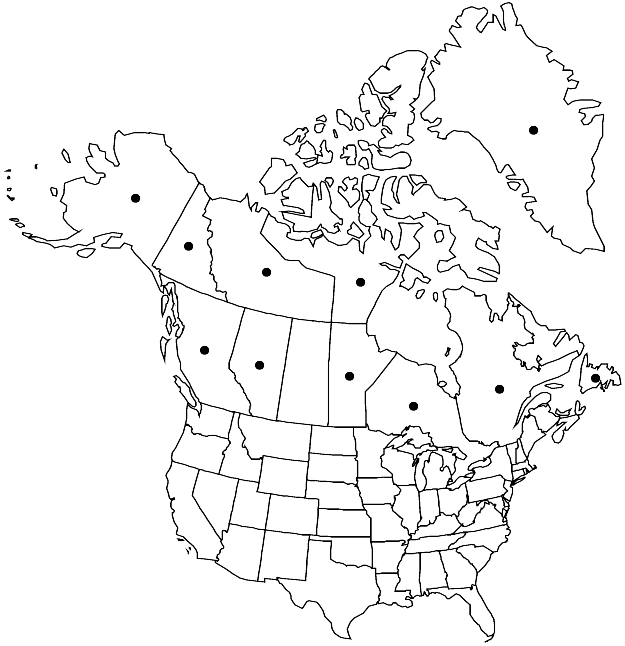Difference between revisions of "Draba nivalis"
Utkast Sv. Fl., 236. 1792.
imported>Volume Importer |
imported>Volume Importer |
||
| Line 50: | Line 50: | ||
|publication year=1792 | |publication year=1792 | ||
|special status= | |special status= | ||
| − | |source xml=https:// | + | |source xml=https://bitbucket.org/aafc-mbb/fna-data-curation/src/2e0870ddd59836b60bcf96646a41e87ea5a5943a/coarse_grained_fna_xml/V7/V7_434.xml |
|tribe=Brassicaceae tribe Arabideae | |tribe=Brassicaceae tribe Arabideae | ||
|genus=Draba | |genus=Draba | ||
Latest revision as of 22:33, 5 November 2020
Perennials; (cespitose, usually forming mats); caudex branched (covered with persistent leaf bases); usually scapose. Stems unbranched, 0.2–0.8(–1.2) dm, pubescent throughout, trichomes minutely stalked, 8–15-rayed, stellate, (non-crisped), 0.03–0.15 mm. Basal leaves rosulate; petiole (obsolete), ciliate throughout; blade oblanceolate to obovate, 0.2–0.9(–1.5) cm × 1–3(–5) mm, margins entire, (not ciliate), surfaces usually pubescent, rarely glabrescent, with short-stalked, 8–15-rayed, stellate, (non-crisped) trichomes, 0.05–0.15 mm. Cauline leaves 0 or 1; sessile; blade ovate or oblong, margins entire, surfaces pubescent as basal. Racemes 3–9(–11)-flowered, ebracteate, elongated in fruit; rachis often slightly flexuous, pubescent as stem. Fruiting pedicels usually ascending, rarely divaricate, straight, 1–4.5(–8) mm, pubescent as stem. Flowers: sepals ovate, 1.5–2 mm, pubescent, (trichomes simple and short-stalked, 2–5-rayed); petals white, spatulate to oblanceolate, 2–3.5 × 0.8–1.4 mm; anthers ovate, 0.2–0.3 mm. Fruits elliptic to narrowly oblong-elliptic, twisted or not, flattened, 3.5–9 × 1.5–2.2 mm; valves usually glabrous, rarely with 3–6-rayed trichomes on replum; ovules 12–24(–28) per ovary; style 0.1–0.4 mm. Seeds ovoid, 0.6–1 × 0.5–0.6 mm. 2n = 16.
Phenology: Flowering Jun–Aug.
Habitat: Rock outcrops and fellfields, meadows, open tundra, stream banks, gravelly beaches, roadsides
Elevation: 0-2500 m
Distribution

Greenland, Alta., B.C., Man., Nfld. and Labr. (Nfld.), N.W.T., Nunavut, Ont., Que., Yukon, Alaska, Europe (Finland, Norway [including Svalbard], n, w Sweden), e Asia (Russian Far East, n Siberia), Atlantic Islands (Iceland), circumpolar.
Discussion
Draba nivalis is most often confused with D. lonchocarpa, and C. L. Hitchcock (1941) reduced the latter to a variety (var. elongata) of D. nivalis. A critical comparison reveals that there are enough differences to warrant their recognition as distinct species. Draba nivalis is distinguished by having non-ciliate leaf bases, basal leaf blades pubescent with trichomes 0.05–0.15 mm, stems and pedicels that are always pubescent, and fruits that are elliptic to narrowly elliptic-oblong, plane, and 3.5–9 mm. By contrast, D. lonchocarpa has ciliate leaf bases, basal leaf blades pubescent with trichomes 0.15–0.5 mm, stems and pedicels that are glabrous or sparsely pubescent, and fruits that are linear to lanceolate or oblong, slightly twisted or plane, and 6–15(–18) mm. Except for Alaska, D. nivalis does not grow in the continental United States, whereas D. lonchocarpa grows in nearly all Mountain and Pacific states.
Selected References
None.